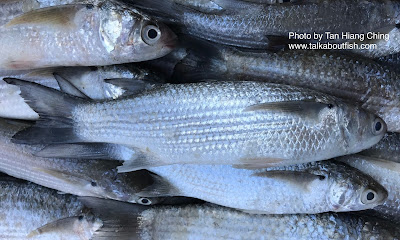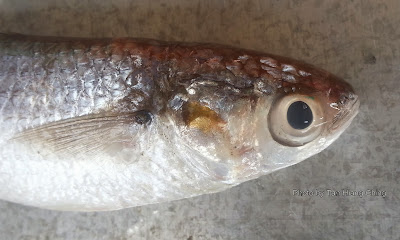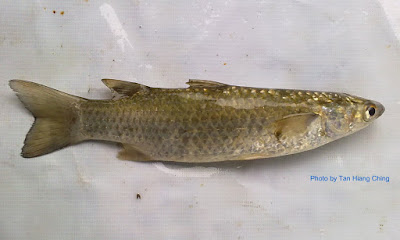Mullets
Mullets are members of the Mugilidae family. They are found in all tropical and temperate seas. Mullets are good food fish, and mullet roe is a delicacy. Most species live close to the shore and often move into river. Some species even inhabit freshwater.
Mullets are schooling fish found inshore in coastal area. They are primarily bottom feeders, living on algae, detritus, and other tiny organism. Mullets have soft and relatively small mouth. They will take a wide range of small and soft bait including bread and worm.
There are 20 genera and about 72 species worldwide. Malaysia is represented by about 12 species.
Mullets are schooling fish found inshore in coastal area. They are primarily bottom feeders, living on algae, detritus, and other tiny organism. Mullets have soft and relatively small mouth. They will take a wide range of small and soft bait including bread and worm.
There are 20 genera and about 72 species worldwide. Malaysia is represented by about 12 species.
Scientific Name: Crenimugil seheli (Forsskål, 1775)
English Name: Bluespot Mullet, Bluetail Mullet, Long-armed Mullet, Long-finned Mullet
Chinese Name | 鱼类中文名: 鲻鱼(Zī yú), 达莫 (Dá mò), 草乌 (Cǎo wū), 乌鱼 (Wū yú)
Malay Name | Nama Melayu Malaysia: Ikan Belanak, Kedera, Jangis, Kedera Tanda Biru
Thai Name | ชื่อสามัญภาษาไทย: ปลากระบอกหางฟ้า (Plā kra bok h̄āng f̂ā)
Local Hokkien: Jee-ah, Or Hu
Main Identification Features: Pectoral axillary scale long. Pectoral fin long, reaching vertical from first dorsal fin origin. Pectoral fin with a blue axillary spot. Scales in lateral series 38 to 42. 9 rows of scales on each side of caudal peduncle. Second dorsal fin origin on vertical from anal fin origin.
Size: Maximum total length at about 60 cm, commonly to 40 cm.
Habitat and Ecology: Inhabits shallow coastal waters, estuaries and freshwater rivers. Forms larger aggregations during spawning which takes place at sea. Feeds on small algae, diatoms and other organic matter, taken with sand and mud.

Scientific Name: Ellochelon vaigiensis (Quoy & Gaimard, 1825)
English Name: Squaretail Mullet
Chinese Name | 鱼类中文名: 鲻鱼(Zī yú), 达莫 (Dá mò), 草乌 (Cǎo wū), 乌鱼 (Wū yú)
Malay Name | Nama Melayu Malaysia: Ikan Belanak, Belanak Loban, Kedera, Tamok
Thai Name | ชื่อสามัญภาษาไทย: ปลากระบอกท่อนใต้ (Plā kra bok th̀on tı̂)
Local Hokkien: Jee-ah, Or Hu
Main Identification Features: Anal fin with 8 soft rays in adults. Caudal fin squarish, its posterior margin nearly straight. Pectoral fins black (lower section yellowish in adults). 2nd dorsal-fin origin level with anterior ⅓ to ½ of anal-fin base.
Size: Maximum total length at about 60 cm.
Habitat and Ecology: Inhabits shallow coastal waters, estuaries and freshwater rivers. Form large schools, frequently in mangrove areas. Feeds on small algae, diatoms, benthic polychaets, molluscs, crustaceans, as well as living and detrital organic matter. Catadromous, migrating from freshwater or brackish water to the sea to spawn.

Scientific Name: Mugil cephalus Linnaeus, 1758
English Name: Flathead Grey Mullet, Striped Mullet, Common Mullet
Chinese Name | 鱼类中文名: 鲻鱼(Zī yú), 达莫 (Dá mò), 草乌 (Cǎo wū), 乌鱼 (Wū yú)
Malay Name | Nama Melayu Malaysia: Ikan Belanak, Belanak, Andapong, Kedera, Tamok
Local Hokkien: Jee-ah, Or Hu
Main Identification Features: Body subcylindrical and anteriorly compressed. Origin of first dorsal fin nearer to snout tip than to caudal fin base. Adipose eyelid well developed, covering most of pupil. Origin of the second dorsal fin is posterior to the origin of the anal fin. Scales in lateral series 36-45. Dark longitudinal lines, formed by dark spots at the center of each scale on the upper half of the body..
Size: Size: Maximum total length 60.0 cm.
Habitat and Ecology: Inhabits coastal waters but enters estuaries and rivers, to 20 m depth. Forms schools. Diurnal feeders, consuming mainly zooplankton, dead plant matter, and detritus associated with sand and mud by sucking up the top layer of sediments. Catadromous, migrating from freshwater or brackish water to the sea to spawn.

Scientific Name: Osteomugil perusii (Valenciennes, 1836)
Common Name: Longfinned Mullet
Chinese Name | 鱼类中文名: 鲻鱼(Zī yú), 达莫 (Dá mò), 草乌 (Cǎo wū), 乌鱼 (Wū yú)
Malay Name | Nama Melayu Malaysia: Ikan Belanak, Kedera, Tamok, Belanak Angin
Local Hokkien: Jee-ah, Or Hu
Main Identification Features: Snout short and blunt. Operculum with gold spot. Pectoral fins with dark spot at base. 2nd dorsal-fin origin in line with 3rd anal-fin soft ray. Caudal fin deeply emarginate.
Size: Maximum total length at about 25 cm.
Habitat and Ecology: Inhabits shallow coastal waters and estuaries. Forms shoals over mudflats.



Scientific Name: Planiliza macrolepis (Smith, 1846)
English Name: Largescale Mullet
Chinese Name | 鱼类中文名: 鲻鱼(Zī yú), 达莫 (Dá mò), 草乌 (Cǎo wū), 乌鱼 (Wū yú)
Malay Name | Nama Melayu Malaysia: Ikan Belanak, Belanak Sisek Besar, Loban, Kedera, Tamok
Local Hokkien: Jee-ah, Or Hu
Main Identification Features: Greenish-grey dorsally; flanks and abdomen silvery; fins grey or bluish with dusky margins and may appear yellowish at base. Pectoral with golden base, and perhaps a dark spot. With rudimentary axillary scale.
Size: Maximum standard length 60 cm, commonly to 26 cm.
Habitat and Ecology: Inhabits shallow coastal waters, estuaries and freshwater rivers. Form large schools during spawning, which takes place at sea. Feeds on small algae, diatoms, foraminifera, benthic polychaets, crustacea, molluscs, organic matter and detritus. Catadromous, migrating from freshwater or brackish water to the sea to spawn.

Scientific Name: Planiliza subviridis (Valenciennes, 1836)
English Name: Greenback Mullet
Chinese Name | 鱼类中文名: 鲻鱼(Zī yú), 达莫 (Dá mò), 草乌 (Cǎo wū), 乌鱼 (Wū yú)
Malay Name | Nama Melayu Malaysia: Ikan Belanak, Loban, Belanak Anding, Kedera, Tamok
Thai Name | ชื่อสามัญภาษาไทย: ปลากระบอกดำ (Plā kra bok dả)
Local Hokkien: Jee-ah, Or Hu
Main Identification Features: Adipose eyefold covering about 1/3 to 1/2 of iris. Dark greenish dorsally and greyish dorsal fins. Caudal fin with black margin. Lacks an enlarged pointed scale at upper pectoral fin base.
Size: Maximum total length at about 45 cm.
Habitat and Ecology: Inhabits shallow coastal waters, estuaries and freshwater rivers. Form large schools. Feeds on microalgae, filamentous algae, diatoms, and benthic detrital material taken in with sand and mud. Fry feeds on zooplankton, diatoms, detrital material and inorganic sediment. Catadromous, migrating from freshwater or brackish water to the sea to spawn.

English Name: Bluespot Mullet, Bluetail Mullet, Long-armed Mullet, Long-finned Mullet
Chinese Name | 鱼类中文名: 鲻鱼(Zī yú), 达莫 (Dá mò), 草乌 (Cǎo wū), 乌鱼 (Wū yú)
Malay Name | Nama Melayu Malaysia: Ikan Belanak, Kedera, Jangis, Kedera Tanda Biru
Thai Name | ชื่อสามัญภาษาไทย: ปลากระบอกหางฟ้า (Plā kra bok h̄āng f̂ā)
Local Hokkien: Jee-ah, Or Hu
Main Identification Features: Pectoral axillary scale long. Pectoral fin long, reaching vertical from first dorsal fin origin. Pectoral fin with a blue axillary spot. Scales in lateral series 38 to 42. 9 rows of scales on each side of caudal peduncle. Second dorsal fin origin on vertical from anal fin origin.
Size: Maximum total length at about 60 cm, commonly to 40 cm.
Habitat and Ecology: Inhabits shallow coastal waters, estuaries and freshwater rivers. Forms larger aggregations during spawning which takes place at sea. Feeds on small algae, diatoms and other organic matter, taken with sand and mud.
Scientific Name: Ellochelon vaigiensis (Quoy & Gaimard, 1825)
English Name: Squaretail Mullet
Chinese Name | 鱼类中文名: 鲻鱼(Zī yú), 达莫 (Dá mò), 草乌 (Cǎo wū), 乌鱼 (Wū yú)
Malay Name | Nama Melayu Malaysia: Ikan Belanak, Belanak Loban, Kedera, Tamok
Thai Name | ชื่อสามัญภาษาไทย: ปลากระบอกท่อนใต้ (Plā kra bok th̀on tı̂)
Local Hokkien: Jee-ah, Or Hu
Main Identification Features: Anal fin with 8 soft rays in adults. Caudal fin squarish, its posterior margin nearly straight. Pectoral fins black (lower section yellowish in adults). 2nd dorsal-fin origin level with anterior ⅓ to ½ of anal-fin base.
Size: Maximum total length at about 60 cm.
Habitat and Ecology: Inhabits shallow coastal waters, estuaries and freshwater rivers. Form large schools, frequently in mangrove areas. Feeds on small algae, diatoms, benthic polychaets, molluscs, crustaceans, as well as living and detrital organic matter. Catadromous, migrating from freshwater or brackish water to the sea to spawn.

Scientific Name: Mugil cephalus Linnaeus, 1758
English Name: Flathead Grey Mullet, Striped Mullet, Common Mullet
Chinese Name | 鱼类中文名: 鲻鱼(Zī yú), 达莫 (Dá mò), 草乌 (Cǎo wū), 乌鱼 (Wū yú)
Malay Name | Nama Melayu Malaysia: Ikan Belanak, Belanak, Andapong, Kedera, Tamok
Local Hokkien: Jee-ah, Or Hu
Main Identification Features: Body subcylindrical and anteriorly compressed. Origin of first dorsal fin nearer to snout tip than to caudal fin base. Adipose eyelid well developed, covering most of pupil. Origin of the second dorsal fin is posterior to the origin of the anal fin. Scales in lateral series 36-45. Dark longitudinal lines, formed by dark spots at the center of each scale on the upper half of the body..
Size: Size: Maximum total length 60.0 cm.
Habitat and Ecology: Inhabits coastal waters but enters estuaries and rivers, to 20 m depth. Forms schools. Diurnal feeders, consuming mainly zooplankton, dead plant matter, and detritus associated with sand and mud by sucking up the top layer of sediments. Catadromous, migrating from freshwater or brackish water to the sea to spawn.

Scientific Name: Osteomugil perusii (Valenciennes, 1836)
Common Name: Longfinned Mullet
Chinese Name | 鱼类中文名: 鲻鱼(Zī yú), 达莫 (Dá mò), 草乌 (Cǎo wū), 乌鱼 (Wū yú)
Malay Name | Nama Melayu Malaysia: Ikan Belanak, Kedera, Tamok, Belanak Angin
Local Hokkien: Jee-ah, Or Hu
Main Identification Features: Snout short and blunt. Operculum with gold spot. Pectoral fins with dark spot at base. 2nd dorsal-fin origin in line with 3rd anal-fin soft ray. Caudal fin deeply emarginate.
Size: Maximum total length at about 25 cm.
Habitat and Ecology: Inhabits shallow coastal waters and estuaries. Forms shoals over mudflats.



Scientific Name: Planiliza macrolepis (Smith, 1846)
English Name: Largescale Mullet
Chinese Name | 鱼类中文名: 鲻鱼(Zī yú), 达莫 (Dá mò), 草乌 (Cǎo wū), 乌鱼 (Wū yú)
Malay Name | Nama Melayu Malaysia: Ikan Belanak, Belanak Sisek Besar, Loban, Kedera, Tamok
Local Hokkien: Jee-ah, Or Hu
Main Identification Features: Greenish-grey dorsally; flanks and abdomen silvery; fins grey or bluish with dusky margins and may appear yellowish at base. Pectoral with golden base, and perhaps a dark spot. With rudimentary axillary scale.
Size: Maximum standard length 60 cm, commonly to 26 cm.
Habitat and Ecology: Inhabits shallow coastal waters, estuaries and freshwater rivers. Form large schools during spawning, which takes place at sea. Feeds on small algae, diatoms, foraminifera, benthic polychaets, crustacea, molluscs, organic matter and detritus. Catadromous, migrating from freshwater or brackish water to the sea to spawn.

Scientific Name: Planiliza subviridis (Valenciennes, 1836)
English Name: Greenback Mullet
Chinese Name | 鱼类中文名: 鲻鱼(Zī yú), 达莫 (Dá mò), 草乌 (Cǎo wū), 乌鱼 (Wū yú)
Malay Name | Nama Melayu Malaysia: Ikan Belanak, Loban, Belanak Anding, Kedera, Tamok
Thai Name | ชื่อสามัญภาษาไทย: ปลากระบอกดำ (Plā kra bok dả)
Local Hokkien: Jee-ah, Or Hu
Main Identification Features: Adipose eyefold covering about 1/3 to 1/2 of iris. Dark greenish dorsally and greyish dorsal fins. Caudal fin with black margin. Lacks an enlarged pointed scale at upper pectoral fin base.
Size: Maximum total length at about 45 cm.
Habitat and Ecology: Inhabits shallow coastal waters, estuaries and freshwater rivers. Form large schools. Feeds on microalgae, filamentous algae, diatoms, and benthic detrital material taken in with sand and mud. Fry feeds on zooplankton, diatoms, detrital material and inorganic sediment. Catadromous, migrating from freshwater or brackish water to the sea to spawn.
